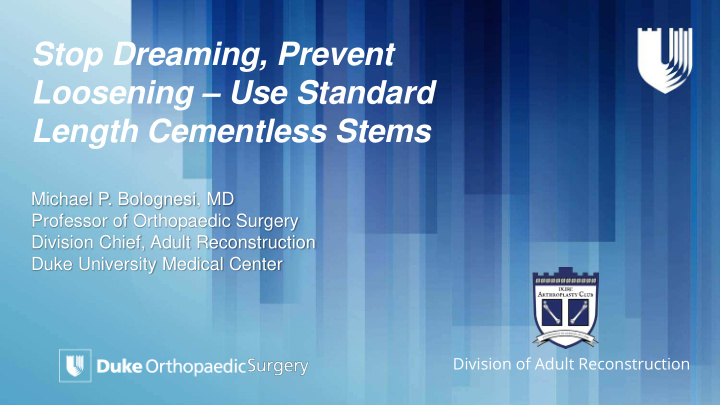



Stop Dreaming, Prevent Loosening – Use Standard Length Cementless Stems Michael P. Bolognesi, MD Professor of Orthopaedic Surgery Division Chief, Adult Reconstruction Duke University Medical Center Division of Adult Reconstruction
Disclosures • Amedica - Stock Options, Surgical Advisory Board • Zimmer Biomet - Royalties, Consulting Payments, Resident Educational Support, Design Surgeon, Research Support • Total Joint Orthopedics - Stock and Stock Options, Advisory Board Member, Resident Educational Support, Consultant Payments, Design Surgeon • Depuy - Research Support, Resident Educational Support, Principal Investigator • Exactech- Research Support, Resident Educational Support • Stryker - Resident Educational Support • Smith and Nephew- Resident Educational Support • SPR- Research Support • Omega - Fellowship Support- Fellowship Director • North American Specialty Hopsital- Advisory Board
Goals of Cementless THA Stem • Osteointegration – Initial stability is key • Subsidence • Rotatory movement – Ingrowth/ ongrowth surface • Ease of use – Works for wide range of femur morphologies – Simple and effective instrumentation • Low fracture rate
Lots of variable to consider… • Porosity: scratch vs. spray vs. mesh • Enhanced Coating • Metal (Titanium, Tantulum….) • Proximal Surface: Length of Ingrowth • Distal Surface: Smooth vs. Ongrowth • Proximal Body Size Options • Neck angle/offset • Modular neck options • Stem: Solid, Hollow, Clothespin • Ideal Length
Different Strategies • Broach only – Blade – Rectangle cross section – Anatomic • Mill only – Wagner taper – SROM • Ream and Broach – Tapered or Not
Classification of Standard Length
Numerous ream and broach options S&N Synergy Depuy Summit Biomet Echo
As well as for broach only….. Zimmer Stryker Smith-Nephew Biomet ML Taper Accolade Anthology Taperloc
Some cases may need a shorter stem Depending on patient-specific factors such as bone mineral density, proximal femoral anatomy and cortical– medullary ratios, this may require different types of stem design with different mechanisms of fixation, and different lengths of stem in different patients.
There are a lot of short stem options!
Can you classify them? 2-Calcar Preserving 1-Femoral Neck Preserving 3-Lateral Flare Design 4-Short Conventional
Advantages Standard Length R and B • They work…. • Independent preparation proximal and distal – Flexibility with bone types • Good A-P fill – Initial stability • Avoid Endless Hammering – Let power tool do some of the work
Advantages Standard Length BO • They work…. • No reaming • Good ML fill to match anotomy • Lower concern for thigh pain?
Cons of Standard Length • R and B can be really hard to get out – Esp if tight distal – Consistent theme among successful stems….. • Harder to use with some approaches? • May see thigh pain with tight diaphyseal fit or varus placement • Less ability to control anteversion? • Intra-op film to evaluate distally?
Concerns about short stems? A few examples….
Loosening Pain and function improved predictably with a 0.55% rate of femoral loosening at 2-year follow-up. Among collared, fully HA-coated and triple taper fit and fill femoral stems, there were no instances of revision for aseptic loosening vs 3 in the short stem, collarless mediolateral tapered group.
Fracture? Seventeen periprosthetic femoral fractures (2.0%) were observed, including 10 intraoperative (1.2%) and 7 postoperative (0.8%) fractures. The occurrence rate of fractures using short stems was significantly higher compared with that using standard stems. The multivariate logistic regression analysis revealed that only stem length was significantly associated with periprosthetic fractures. Conclusion: Our results indicate that the stem design affects the risk of periprosthetic femoral fractures.
Conclusions… • What are we trying to fix? • Not sure there are any real issues with standard length stems • Need to follow all stems for different modes of failure. • Is stem collection related to approach the right thing to do?
Thanks!
Moving forward. Climbing higher.
Recommend
More recommend